|
|||||||||||||||||||||||||||
|
|||||||||||||||||||||||||||
|
|||||||||||||||||||||||||||
|
|||||||||||||||||||||||||||
|
|
|
|
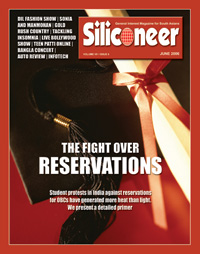
JUNE 2006 |
|
||||
|
EDITORIAL: 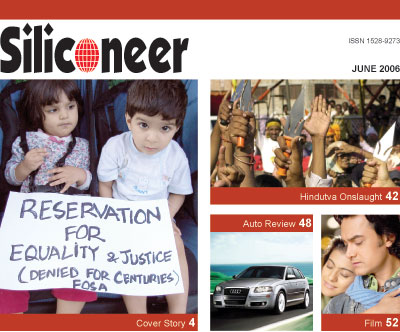 THE RESERVATIONS THE RESERVATIONSCONTROVERSY You would think the world was coming to an end. The furore in India over the government’s decision to back reservations for the underprivileged created the sort of turmoil that echoed the violent Mandal Commission protests in the 1980s that brought down the government of V.P. Singh. One can sympathize with the students; after all, the bottom line is that there are woefully few spots for a top-class technical education for anyone in India, and getting in is murderously competitive. Many of these protesting students and doctors have worked hard to get in, and many were raised in ordinary middle class homes. But take a closer look, and you are bound to begin to have some qualms. To many of us, student life is a time of idealism, a time of selfless commitment to causes larger than oneself. What we are seeing here? If anything, it’s a total self-absorption that is appalling in its selfishness. These guys think they are the smartest folks, and they own the world, and the rest of the world can go take a hike. You have to wonder: If this is what they are like when they are students, what are they going to be like when they enter the professional world? Alas, you don’t have to look very far for the answer. In India, unfortunately, it’s everywhere. You don’t have to be a rocket scientist to realize that any system that allows less than 10 percent of its population — that’s a rough estimate of the size of the upper castes — to hog 90 percent or more of top jobs anywhere is simply out of whack. When (upper caste) students fail to recognize this simple fact, you have to wonder what on earth they mean by merit. Of course, this is not a popular viewpoint. Expatriate Indians, the bulk of them upper caste, have shown a unanimous solidarity with the students that would do the Nazis proud. Added to arrogance is the sanctimonious claim that politicians are playing identity politics. Time for a reality check: Reservations are not about politicians. It’s about a government panel’s well-considered deliberations made 25 years ago that have withstood court challenges to be endorsed by the Indian Supreme Court. In principle, reservations are enshrined in the Indian Constitution. The terrible wrongs of millennial oppression cannot be redressed without causing some pain. It behooves on those who have enjoyed an outrageously large share of society’s benefits for generations to make way for those who haven’t, with a modicum of grace if not with pleasure. Our editorial stand is obvious, and our cover story reinforces it. However, we also include a dissenting view from a Bay area group that backs the (read upper caste) student movement to roll back reservations. Now on to something more pleasant. We would be the first to admit that a fashion show is not the most cerebral of pursuits, but Dil’s San Francisco chapter’s ideal is lofty enough to draw both our respect and affection. DIL is primarily an effort by women to help less fortunate, future women, and it targets low female literacy rates in Pakistan and focuses its efforts on educating girl-children in the poorest and most backward areas of the country. The nonprofit Development in Literacy raised over $75,000 towards education of underprivileged girl children, and honestly, we cannot think of a more heartwarming, substantive gesture towards changing an underprivileged part of society. COVER STORY: The Furore Over Reservations: A Primer Students from some of the elite Indian institutions have been on a rampage in a protest against the government decision to implement a recommendation that 27 percent of seats in higher educational institutions be reserved for a group of disadvantaged people who are officially labeled “Other Backward Classes.” Rallying under such names as “Youths for Equality,” protesters would have you believe that this is a ploy by politicians to grab the vote banks of backward castes, giving merit short shrift. Many commentators and analysts have joined the bandwagon. Is it coincidental that pretty much every protester belongs to the upper castes, a thin sliver of the Indian polity that has a virtual stranglehold of top jobs? Did you know that the government is merely implementing a policy that was recommended way back in 1980 by the Mandal Commission? Who are the Other Backward Classes? Get the facts in the following primer on the reservations debate that has India in turmoil. The primer is the collective effort of Girish Agrawal, Shalini Gera, Sanjeev Mahajan, Anu Mandavilli, Ra Ravishankar, Ramkumar Sridharan and Raja Swamy, on behalf of Friends of South Asia. 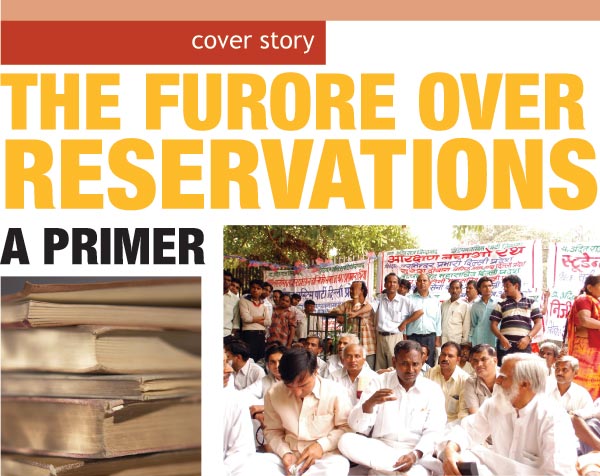 A rally in Delhi in support of reservations. Who are the OBCs? OBC stands for Other Backward Classes. A community is classified as “OBC” if it qualifies as “backward” based on a complex set of social, economic and educational criteria, as specified by the National Commission on Backward Classes (NCBC)1 “The OBCs comprise, by and large, the lower rungs of the Sudras who, in the past, suffered from varying degrees of ritual prohibitions applied to the a-dvijas (literally, those not twice-born) and remain till today socially and occupationally disadvantaged.”2
“In absolute size, the OBC poor outnumber SC as well as ST poor population and account for more than half the poor population in the category of (residual non-SC, non-ST) others in both the rural and the urban areas and 31.5 percent (rural) and 38.2 percent (urban) of entire poor population.”4 Specifically in terms of defining OBCs in the context of reservations, one of the key observations of the Mandal Commission was that quantifying social, educational and social levels of each and every community in India would be a logistical nightmare and would invite large-scale corruption. The commission pointed out that many empirical studies indicate that there is a strong correlation between social, educational, and economic backwardness and membership in certain lower castes. So the commission suggested that instead of evaluating all the communities, it would be more practical to consider such castes as potential candidates for being classified as OBC. Once this has been done, one can then look at these castes more closely and determine if their social, economic and educational levels are below a certain predefined threshold. Defined thus, OBC is a dynamic notion. For instance, if a community X improves dramatically in social, economic and educational indicators, it ceases to be classified as OBC. Note that this implies that evaluation of a community’s backwardness should be done periodically to determine if it still qualifies as being OBC. For a candidate to qualify for an OBC reserved seat, it is necessary that they belong to an OBC community, but such membership in an OBC community is not a sufficient condition. The candidate would also then have to show that her family’s economic and/or educational levels are also not too high, in order to avoid the “creamy-layer” exception. But are the OBCs really discriminated against? Don’t they already hold a significant amount political power? The answer to the previous question should also provide an answer to this question. Since OBC communities are by definition those communities that have dramatically low social, economic, and educational levels, one can plausibly argue that their dismal state is a consequence of systemic discrimination. As for political power, yes, lower castes are in power in the states of both U.P. and Bihar, but most of the administrative machinery including the police force is under the control of upper castes. Would a poor upper-caste person be able to avail of reservations? Why isn’t the criterion for determining who benefits from reservations purely economic? The suggestion of using only economic criteria to address caste-based inequality is like saying that we should not address gender discrimination as an issue primarily concerning women, since men are also sometimes oppressed. While it is true that there are poor people among the upper castes too, reservations are specifically intended to address massive, systemic, historical subjugation of entire communities. Reservations are not meant as a tool for eliminating economic disparities across the board. That said, economics do play an important factor in determining which communities are OBC and deserve reservation. As stated earlier, OBC stands for “Other Backward Classes,” and in accordance with the Mandal Commission recommendations, for a community to be classified as OBC, it must meet a complex set of social, economic and educational criteria. While this cannot ensure that every single individual who qualifies for reservation is truly “oppressed,” the procedures are designed to ensure that the bulk of the beneficiaries are socially as well as economically backward. The fact that most OBCs also happen to be lower castes is simply a reflection of how the upper castes control a disproportionate share of the nation’s resources. Why should the son of an IAS officer benefit from reservations? In general, why should the “creamy layer”, or the well-to-do members of OBC communities get reservations? As we pointed out in the answer to the first question, membership in a community identified as OBC is a necessary, but not a sufficient condition to qualify for the OBC quota. Specifically, the National Commission of Backward Classes provides a list of persons/sections who are excluded from reservation because they constitute the “creamy layer” of the society.5 Sons/daughters of individuals who are classified as falling under the “creamy layer” cannot be considered eligible for reservation. The “creamy layer” spans various categories, including constitutional posts (president/vice president, supreme court/high court judges, etc), Class I/II officers (in Indian central and state government services), certain employees in public sector undertakings, high-ranking armed force officials, doctors, engineers and other professionals who possess a high level of income/wealth, property owners, and others whose income/wealth is above a certain level.
As described earlier, OBC is a dynamic notion. The evaluation of whether given communities qualify to be designated OBC is to be done periodically6 and if a community advances such that its socio-economic and educational levels are on par with state or district average, it ceases to be classified as OBC. The Supreme Court has mandated that a revision of this list needs to take place at least once every 10 years.7 As envisaged by the Mandal Commission, and as proposed to be implemented now, the policy of reservations is not the blunt instrument that it is falsely portrayed to be. It is a fine-grained program that will not result in an ever-increasing number of ‘reserved’ places at the table, but will more than likely always stay below the target threshold of 27 percent because it is designed to use overlapping measures of social and economic deprivation and fluid notions of identity and group belonging — dynamic measures that are subject to continual readjustments to minimize economic and social disparities as society changes. Are reservations the best way to ensure better representation of socially disadvantaged groups? Are there studies showing their efficacy? Yes, it is true that the disadvantaged should have access to high quality primary education. Yes, imaginative solutions should be found to overcome the centuries-old practice of caste-based discrimination, but none of this precludes reservation as a corrective measure. Reservations cannot take the place of comprehensive societal changes, but they constitute a very important, necessary step in the process of compensating for centuries of discrimination. Reservations promote integration in the upper strata of society — by increasing the access of highly disadvantaged and under-represented communities to elite occupations and decision-making positions. In this manner, reservations result in greater empowerment of hitherto disadvantaged communities. A study on the impact of three decades of reservations in higher education for the SC/ST community in India8 shows that “reservation policies at all levels of higher education both redistribute SC and ST students upward in the university quality hierarchy and attract into universities significant numbers of SC and ST students who would not otherwise pursue higher education.” This study also found that while such reservations were mostly availed of by the more well-off section of the SC/ST population, this was not surprising due to the immense challenges faced by the poorest of the poor in persisting through school in order to reach higher education. In addition, the average socio-economic status of the SC/ST students was significantly lower than that of other students, thus suggesting that reservation policy did not benefit well-off SC/ST students at the expense of less-well-off applicants from the rest of the population. How about relying on merit to determine admissions? Is that not a neutral criterion?
Further, it is a false claim that students who enter universities through the reserved category are undeserving or unqualified compared to those coming through the general category. Students who make it through the reserved category still have to meet rigorous qualification criteria. Reservations only play a role in determining which subset of qualified people get access to the limited number of available seats. It is also a little odd to assume that someone who was admitted into, say, a medical college under a reserved category and completes the requirements for his or her degree would not make a good doctor. Because degrees are granted only after students successfully fulfill all academic requirements of the program, it is hardly relevant whether someone initially gained admission through reservations or not. Don’t caste-based reservations result in further promoting casteism? Reservations do not enforce or promote casteism. Rather, they are an acknowledgement of its brutal reality, and attempt to provide corrective measures to compensate for the centuries of oppression faced by lower castes, and the resultant inequalities of contemporary society. Opposing caste-based reservations for the sake of “equality” is disingenuous, since this argument is in denial of the fact that caste-based inequality already exists. Very much like apartheid in South Africa, slavery in the United States and post-Civil War segregation and exploitation of blacks, the caste system not only drastically exploited Dalits and other lower caste groups, it also concentrated advantage in the three upper-caste groups. Despite accounting for only around 10 percent of the population, upper castes in India control virtually everything. Nearly sixty years after independence from British rule, upper-caste individuals continue to hold an overwhelming majority of academic, administrative and executive positions, including over 95 percent of the appellate judicial positions. The upper castes also control more than two-thirds of the nation’s wealth. Even within the upper caste groups, Brahmins, less than three percent of the population, occupy nearly all the upper rungs of federal administrative structure and most of the senior academic positions. To question this extremely lopsided distribution of power is the ethical responsibility of all Indians, but in particular that of all upper-caste Indians. During the civil rights movement in the deep South, the white racists argued that the movement was creating schisms between blacks and whites, and that the violent reaction of whites was essentially a result of agitators from the North creating dissatisfaction among blacks who were otherwise quite happy with their situation. Protests by upper-caste Indians (who constitute less than 15 percent of Indian population) against the attempts of Indian government to make elite educational institutions accessible to people who have suffered under the millennia-old tyrannical and brutal caste system are also equally disingenuous. Is not the government pandering to vote bank politics by announcing these reservations? Instead, would it not be better if the government worked for the national interest? This question involves a clarification of what constitutes a democracy. A democratically elected government is necessarily accountable to the people who elected it. In so far as the OBCs constitute a sizeable portion of Indian society, reservations that are meant to ameliorate their socio-economic condition do serve the greater common good. If the accusation is that the government announced 27 percent quota for OBCs to get re-elected, then the government is guilty as accused. Of course, every elected government wants to get re-elected. That is what democratic politics is all about. As for the national interest, this concept has mostly been used to further whatever is in the best interests of the country’s elite, and unless one defines precisely what it is supposed to mean in a more substantive way, one cannot build a reservation policy based upon it. . We are talking about reservations for the OBCs in particular. What percentage of the Indian population is OBC?
Due to space restrictions, we could not present some statistical tables that provide graphic evidence of upper caste hegemony. These tables and more information on the reservation debate are available at the Friends of South Asia Web site at: www.friendsofsouthasia.org/caste/reservations Notes
|TOP|
PROTEST: Are Reservations A Good Idea? No, Do a Study First The Indian government’s decision to implement an additional 27 percent caste-based reservations in higher educational institutions is not backed by facts or figures but instead motivated by caste-based vote politics, writes Manish Lohani on behalf of Bay Area Indians for Equality. 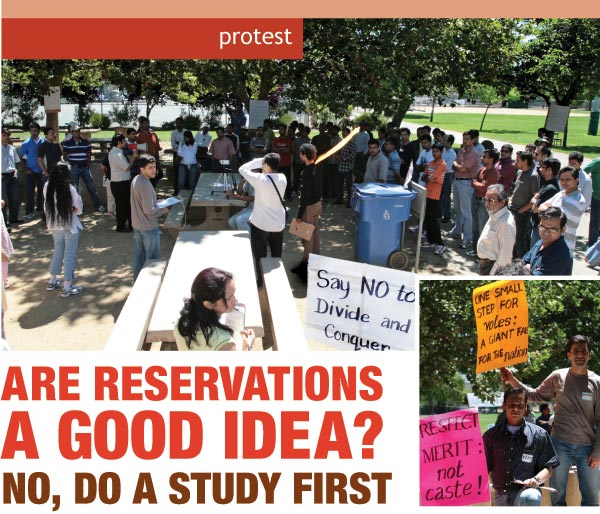 Some of the 500 Indian American protesters who gathered at the Fair Oaks Park in Sunnyvale, Calif., to protest the indian government’s decision to implement a 1980 panel recommendation to reserve 27 seats in higher educational institutions for Other Backward Classes. The Indian government has recently decided to implement an additional 27 percent caste-based reservations in all higher educational institutions in the country. While we all have our personal opinions on whether reservation in any form is good or bad, we believe that the current policy and implementation is wrong, because it is not backed by facts or figures but instead motivated by caste-based vote politics. Let us be clear: We believe in affirmative action. What we are saying to the Indian government is this: Show us the evidence that it has done proper study/analysis of the problem and the current policy will solve the problem. If it has not already done this study, then it should first do it and only then implement whatever is the recommendation of such an analysis. The fact that the government does not want to study the problem before implementing it suggests that its motive is not really solving the problem but to divide people on the basis of caste. We reject caste-based politics outright and do not believe that it will help us build a casteless society. If by spending a few months on the problem, we can build a general consensus for a solution and avoid caste-based politics, it will only strengthen the social fabric and be more beneficial to the disadvantaged. Various organizations and individuals have urged the government to justify its move and provide more transparency on this policy intervention, which is going to directly affect many people and influence the social and economic future of the country. Lack of any response from the government on the above demands has raised concerns that the policy may be motivated by personal agenda rather than national interest. The goal of our group, Bay Area Indians for Equality, is to unite together and send a strong signal to the Indian government that in a democracy, people want more transparency in decision making. Our aim is to urge the government to justify whatever policy it comes up with, and to back it with facts and figures. We demand that: An expert committee be formed comprising apolitical eminent experts of repute to review the current caste-based reservation policy of the government. The objective of such a committee will be to explore various approaches to affirmative action not limited to reservations. Till such a committee comes out with its recommendations, the implementation of the current caste-based reservation policy be put on hold. The recommendations and analysis of such a committee be made available to public. A lot of us are not directly affected by the current reservation policy by the government. It is precisely why we should take a stand. Being non-resident Indians, we have a unique perspective on the issue. We need to become a voice for the interest of the country since the government does not seem to be working for it. This issue is relevant to every Indian who has any stake in the future of India. So, if you have family/social /business/cultural ties to India, this issue is relevant to you. Specifically, this issue is relevant to you if:
While the Indian government has set up a review committee to oversee the implementation of the current policy of 27 percent reservation for OBCs in central educational institutes, it has no intention as of now to review the policy itself. - Manish Lohani is a Bay Area-based professional and |TOP| NEWS DIARY: May Roundup  Court Orders $1.2M Award | Indians Sweep National Geographic Bee | Sensex Free Fall | Politician’s Son Makes Recovery | Indian Wins $50,000 Top Intel Science Award | Bangla Factory Riots | Five Given Ellis Island Medals of Honor | Hybrid from Delhi | Joint Moon Venture | Two in USA Today’s Academic Team | Docs End Strike | Maoists Rally in Nepal | Left Sweeps Polls | Cloistered Scientist Court Orders $1.2M Award | Indians Sweep National Geographic Bee | Sensex Free Fall | Politician’s Son Makes Recovery | Indian Wins $50,000 Top Intel Science Award | Bangla Factory Riots | Five Given Ellis Island Medals of Honor | Hybrid from Delhi | Joint Moon Venture | Two in USA Today’s Academic Team | Docs End Strike | Maoists Rally in Nepal | Left Sweeps Polls | Cloistered ScientistCourt Orders $1.2M Award A federal judge has awarded a group of 52 Indian men more than $1.2 million after finding an oil equipment manufacturer guilty of fraud, false imprisonment and civil rights violations. U.S. District Chief Judge Claire Eagan’s ruling May 24 described an environment of threats and intimidation, daily harassment and open hostility from management at the John Pickle Co. “Defendants recruited Indian workers in India, brought them to the United States, housed and fed them separately from the non-Indian JPC employees, identified them as Indians and made numerous discriminatory comments about their ancestry, ethnic background, culture and country,” Eagan wrote. The verdict came more than four years after the workers left the factory. John Pickle Co. ceased operations shortly thereafter and there was no way to reach company officials. The company has maintained its innocence. Joseph Chakkungal, an oil refinery worker, had emptied his savings and sold his motorcycle to move to the United States. He made three 36-hour trips from his hometown to Mumbai, completed interviews with Al-Samit International, an Indian recruitment agency, and had met with John Pickle himself. When he learned he had made the cut, he quit his $300-a-month job as a vessel fitter at an oil refinery and packed his bags. Balaraju Salapu, a 31-year-old newlywed, bid farewell to his pregnant wife, convinced he could build a better life for his family here. He and others say they were told they’d receive at least two years’ work with American wages, have nice apartments with a pool and gym, free food, medical care, a car for every four of them — and if they did well, a chance to bring their families here. But nothing was to be. The men said they were forced to work long hours for only a few dollars per day. They also accused the company of making them live in a dormitory on the factory grounds and keeping them from leaving, even when off-duty. If divided equally, Chakkungal and Salapu and all other workers might receive more than $20,000 each. |Back to NEWS Diary| |TOP| Indians Sweep National Geographic Bee  Bonny Jain holds up a $25,000 cafter winning the 2006 National Geographic Bee. Three Indian American eighth graders from Illinois, New Hampshire and Georgia swept the top three places in the 2006 National Geographic Bee, held May 24 in Washington, D.C. Twelve-year-old Bonny Jain from Woodrow Wilson Middle School in Moline, Ill., scrawled the word “Cambrian” to win a tiebreaker by answering the question: “Name the mountains that extend across much of Wales from the Irish Sea to the Bristol Channel.” Jain won a $25,000 scholarship and a lifetime membership in the National Geographic Society, the sponsoring organization. Seven Indian American students figured among 55 finalists representing the 50 states, the District of Columbia and four U.S. territories. Six of the seven made it into the top 10. Taking second place and winning a $15,000 scholarship was Neeraj S. Sirdeshmukh, 14, of Fairgrounds Middle School in Nashua, N.H. Capturing third place and a $10,000 award was Yeshwanth R. Kandimalla, 13, of Simpson Middle School in Marietta, Ga., Jeopardy! game show host Alex Trebek emceed the national geography competition for students in grades four through eight. Trebek noted that Jain’s fourth place finish in 2005 turned out to be lucky. If he had placed second or third, he would not have been allowed to compete this year, according to contest rules. “(Last year), I wanted first most, then fourth,” Jain told one reporter. “It feels pretty cool to have gotten up to the top of the nation from second in the school,” he said. Each of the other seven finalists in the top 10 received $500 scholarship awards. They included Suneil K. Iyer, 11, of Havencraft Elementary School in Olathe, Kansas; Krishnan V. Chandra, 13, of West Middle School in Andover, Mass; and Matthew J. Vengalil, 13, of Parcells Middle School in Grosse Pointe Woods, Mich. Nirbhay Jain of Ottawa Hills Junior High in Toledo, Ohio. |Back to NEWS Diary| |TOP| Sensex Free Fall  A Mumbai stockbroker watches his terminal during trading as Indian shares plunge. A Mumbai stockbroker watches his terminal during trading as Indian shares plunge.A bout of panic selling triggered by a global meltdown, pushed the benchmark Sensex down by over 674 points at mid-session on the Bombay Stock Exchange May 31. The Sensex dropped by 674.67 points to touch 10,111.96 at 1330 hrs, while the National Stock Exchange index Nifty fell by 12.40 points at 2,972.90. Metal stocks led the downward rally, losing over 558 points, influenced by overnight weakness in base metal prices in the London Metal Exchange. A robust 8.4 percent growth in GDP failed to have any impact on the market. All the 30 sensex related scrips were deep in the red with ONGC, Tata Steel, Grasim Industries, TC Ltd, Housing Development Finance Corporation and Hero Honda leading the losers pack. The downfall in the metal stocks reflected in the BSE-metal index, which was down by 7 per cent closely followed by the BSE-FMCG index down 6.49 percent. BSE PSU index was also in the red by 5.68 per cent from its previous close of 5438.80. Finance Minister P. Chidambaram said the fall in stock market would not affect consumer demand, even as he attributed selling by FIIs partly to a meltdown in global meltdown. “Our consumer demand is very huge and our growth is driven largely by domestic demand... Global markets are down and it is partly reflected on Indian markets also,” he told reporters here. |Back to NEWS Diary| |TOP| Politician’s Son Makes Recovery 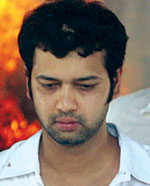 The son of a leading Indian politician killed last month is recovering in hospital after suffering from a mysterious ailment, doctors say. Rahul Mahajan was taken critically ill and an associate of his found dead from the same condition. The son of a leading Indian politician killed last month is recovering in hospital after suffering from a mysterious ailment, doctors say. Rahul Mahajan was taken critically ill and an associate of his found dead from the same condition. They were taken ill after the two ate a meal at Mahajan’s house in Delhi. Police are questioning three men who visited the house. It has emerged that traces of drugs have been found. Results of a post mortem on Mahajan’s companion are still awaited. Doctors said earlier that initial reports suggested both men had been food poisoned. The incident came less than a month after Mahajan’s father, Pramod Mahajan, a former government minister, was shot dead by his own brother. |Back to NEWS Diary| |TOP| Indian Wins $50,000 Top Intel Science Award 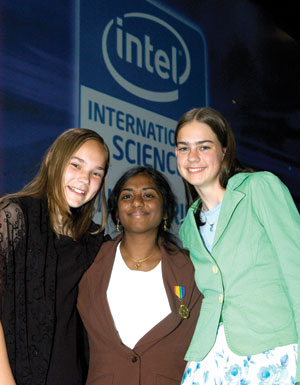 Madhavi Gavini flanked by Hannah Wolf (l) and Meredith MacGregor. All three got top honors at the 2006 Intel International Science and Engineering Fair in Indianapolis May 12. Madhavi Gavini flanked by Hannah Wolf (l) and Meredith MacGregor. All three got top honors at the 2006 Intel International Science and Engineering Fair in Indianapolis May 12.Indian American Madhavi Gavini is among three young scientists to win one of the world’s top science and technology awards for high school students. The Starkville, Miss., high school junior, along with Meredith MacGregor of Boulder, Colo.; and Hannah Wolf of Allentown, Pa., received a $50,000 Intel Foundation Young Scientist Scholarship May 12 by taking top honors at the Intel International Science and Engineering Fair 2006. They excelled among a worldwide pool of 1,482 competitors from 47 countries, regions and territories. “It is a privilege to meet these outstanding young people and be inspired by their curiosity, enthusiasm and dedication,” said Craig Barrett, Intel chairman. “This generation of young scientists and inventors will surely find solutions to global issues and change the world for the better.” Nearly 1,500 students from over 47 countries competed for $1 million in scholarships, grants and scientific field trips. In addition to Gavini, at least 34 Indian Americans and 2 Indo-Canadians are among award winners in 14 scientific disciplines. In addition, five students from India and one from Pakistan have also won an Intel Award this year. Gavini, 16, discovered a novel method to destroy a common and deadly infectious bacterium — Pseudomonas aeruginosa — that causes secondary infections that often lead to death in patients with compromised immune systems, such as those with cancer, AIDS and serious burns. The idea for the project came after she received a five-volume set of books on Indian medicinal plants from her Kerala-based grandfather M.V.K. Warrier, an ayurvedic physician, historian and editor of a ayurvedic magazine called Aryavaidya. |Back to NEWS Diary| |TOP| Bangla Factory Riots 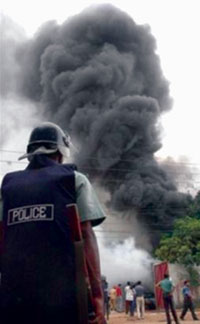 A riot policeman stands guard outside a garment factory set afire by workers in Dhaka. A riot policeman stands guard outside a garment factory set afire by workers in Dhaka.Police and security forces have been deployed to protect garment factories in industrial areas of Bangladesh. The operation has prevented a repeat of widespread rioting which destroyed or damaged dozens of factories. Many owners kept their businesses closed for fear of more attacks. Only about a quarter of the factories in the capital, Dhaka, were operating. Unions say garment workers are angry over low pay and long hours. Wages in Bangladesh’s garment factories can be as little as $20 a month. All through the working day, the police, the paramilitary Bangladesh Rifles and the Rapid Action Battalion were deployed in heavy numbers around garment factories. The garment industry, which brings in 80 percent of Bangladesh’s exports, has been hit badly by three days of rioting in a week. What began as a dispute over dismissals in a single factory quickly spread to engulf industrial areas. Factory owners and the government have suggested a conspiracy may be behind the violence. Some owners have claimed that agents from rival garment-producing countries might be stirring up discontent. Bangladesh’s industry has grown by about 20 percent since a quota system that regulated the world’s garment trade was phased out at the start of 2005. Later, the government sacked the head of the Economic Processing Zone. The readymade garment industry in Bangladesh employs about two million workers, mostly women. Last year, it earned about $6 billion — about 80 percent of the country’s total export income. |Back to NEWS Diary| |TOP| Five Given Ellis Island Medals of Honor Five Indian Americans received the Ellis Island Medal of Honor at a ceremony in New York May 13: New Age guru Deepak Chopra; Dr. Navin C. Mehta of New York; Dr. Navin Nanda, director of the Heart Station/Echocardiography Laboratories at the University of Alabama at Birmingham; Utah entrepreneur Dinesh Patel; and Niranjan Shah, chairman and CEO of the Chicago-based Globetrotters Engineering Corporation.  Awarded by the New York-based National Ethnic Coalition of Organizations, Ellis Island medal winners are listed in the Congressional Record. The Ellis Island Medal of Honor is one of the highest awards to immigrants. Previous honorees include U.S. presidents, Nobel Prize winners and noted leaders of minority communities. |Back to NEWS Diary| |TOP| Hybrid from Delhi  A hybrid car designed by students of the Delhi College of Engineering was displayed at the 18th annual Tour de Sol, or Green Car Festival, in Saratoga Spa State Park, N.Y. A hybrid car designed by students of the Delhi College of Engineering was displayed at the 18th annual Tour de Sol, or Green Car Festival, in Saratoga Spa State Park, N.Y.The car, named Fledge, has been designed to meet the world’s need for clean vehicles and suit Indian lifestyle and driving conditions. It runs on gasoline and electricity. It was built by seven students of the DCE — Abhinav Bhatia, Abhinav Duggal, Abhishek Agarwal, Anubhav Jain, Ashish Dudani, Nitesh Gupta and Siddharth Arora — all in the 6th semester of their bachelor’s course in mechanical engineering. “Necessity is the mother of all inventions and the mounting burden of petroleum prices on the common man has kindled a spark in the DCE students to unearth this new technology with a revolutionary drive train,” team leader Agarwal said. The prototype was built with the assistance of carmaker Mahindra and Mahindra and funding from the Department of Science and Technology. Power transmission in the hybrid car occurs on the engine as well as on the motor mode providing the user with an option of switching to either mode at any point of their journey, the students said in a release. It is powered by an 18BHP, 346cc engine along with a 3.5HP, 3000 rpm permanent magnet DC motor. Fledge employs its customized drive train incorporating less complex components, making it more efficient. It has near zero emissions in urban conditions. |Back to NEWS Diary| |TOP| Joint Moon Venture ISRO chairman G. Madhavan Nair and NASA administrator Dr. Michael Griffin, signed Memoranda of Understanding at the ISRO Satellite Centre in Bangalore on inclusion of two U.S. scientific instruments on board India’s first mission to the moon, Chandrayaan-1. These instruments are a mini synthetic aperture radar developed by applied physics laboratory, Johns Hopkins University and funded by NASA and Moon Mineralogy Mapper), jointly built by Brown University and Jet Propulsion Laboratory of NASA. Chandrayaan-1, scheduled during 2007-2008, is India’s first unmanned scientific mission to moon. The main objective is the investigation of the distribution of various minerals and chemical elements and high-resolution three-dimensional mapping of the entire lunar surface. ISRO’s Polar Satellite Launch Vehicle, PSLV, will launch Chandrayaan-1 into a 240 km x 24,000 km earth orbit. Subsequently, the spacecraft’s own propulsion system would be used to place it in a 100 km polar orbit around the moon. The two U.S. instruments, Mini SAR and M3, were selected on the basis of merit out of 16 firm proposals from all over the world received in response to ISRO’s announcement of opportunity. The main objective of Mini SAR is to detect water in the permanently shadowed areas of lunar polar regions. The objective of M3 is the characterization and mapping of minerals on the lunar surface. The inclusion of US instruments on Chandrayaan-1 has added a fillip to the Indo-US cooperation in the space arena which dates back to the very beginning of the Indian space program. More recently, the India-U.S. Conference on Space Science, Applications and Commerce held at Bangalore during in June 2004 led to the setting up of a Joint Working Group to enhance the cooperation in civil space between India and the U.S. |Back to NEWS Diary| |TOP| Two in USA Today’s Academic Team  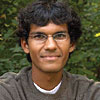 Two Indian American students, Shiv Gaglani (r) of Melbourne, Fla., and Anish Mehta (l) of Cincinnati, have been named in USA Today’s 2006 All-USA High School Academic First Team. Six others were included in the second team, and three more in the third team. Seven students received honorable mention. Two Indian American students, Shiv Gaglani (r) of Melbourne, Fla., and Anish Mehta (l) of Cincinnati, have been named in USA Today’s 2006 All-USA High School Academic First Team. Six others were included in the second team, and three more in the third team. Seven students received honorable mention.Gaglani is a previous winner at the Intel Science and Engineering Fair and a Presidential Scholar. With a GPA of 4.0, he has been admitted by Harvard University. Working with a Clemson professor aiming to modify inkjet printers for use in tissue engineering, he advanced a branching method that may one day be used to “print” a rudimentary blood vessel, USA Today said. That achievement earned him a second place Grand Award at the Intel science fair. Mehta, 17, has joined the University of Pennsylvania. He spent two summers volunteering with Soteni International in Kenya, building a census database on rural children and developing programs for AIDS orphans, and also founded a Soteni Club at his school to raise awareness. A student body vice president, Mehta was a member of the school’s Mock Trial Team and has won the best attorney award. Also, he won four gold medals and one perfect score in the National Latin Exam. The following were named in All-USA High School Academic Second Team: Aditya Joshi, Sheela Krishnan, Kiran Pendri, Nimish Ramanlal, Raj Ranade, Ritu Varadarajan. The following were on the All-USA High School Academic Third Team: Abhiram Bhashyam, Sameer Gupta, Vinayak Muralidhar. The following won honorable mention: Nikhil Nevrekar, Sukrit Ranjan, Amulya Bhagat, Amol Jain, Anarghya Vardhana, Ameya Velingker, and Neil Parikh. |Back to NEWS Diary| |TOP| Docs End Strike 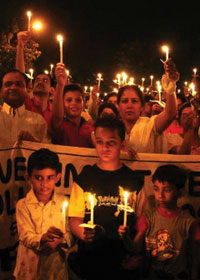 Doctors, with their children, at a candlelight protest in Chandigarh. Doctors, with their children, at a candlelight protest in Chandigarh.Doctors and medical students protesting against a controversial affirmative action plan in India called off a strike following a Supreme Court order. The court had said the strike was inconveniencing a large number of patients and ordered the doctors to return to work. The doctors and medical students had been on strike for nearly three weeks. They were protesting a plan to reserve half of state-funded professional college places for lower castes. Those opposing the affirmative action plan say it will lead to lower standards. The Supreme Court said the government should assure the doctors that they would face no punishment after they called off their strike. The court also said the doctors whose services were terminated due to the strike would be recalled when they returned to work. Earlier, the Supreme Court questioned the affirmative action proposal and asked the government to provide details within eight weeks of the rationale for the plan and how it would be implemented. Under the new plan, the government intends to reserve nearly half of state-funded professional college places for lower caste students from 2007. The new plan would set aside an additional 27 percent of places in educational institutions for Other Backward Classes. Many Indians fear this would mean fewer college places and lower standards, but the move has the backing of millions of lower caste Indians and other disadvantaged groups. |Back to NEWS Diary| |TOP| Maoists Rally in Nepal Their fists raised in the air and clutching red flags, some 200,000 Nepalis gathered in the capital for the first Maoist rally in three years to build pressure for a constituent assembly to decide the country’s future. Tens of thousands of people filled into a public ground in Kathmandu, many berating King Gyanendra. Chants of “Gyanendra thief, leave the country” and “Hang Gyanendra” were heard. Weeks of violent street protests forced Gyanendra in April to give up his absolute grip on power, reinstate the parliament he disbanded in 2002 and return power to political parties. The Maoists have held rallies outside the capital to win support since Nepal’s new multi-party government last month matched an earlier cease-fire declared by the militants. Krishna Bahadur Mahara, the chief Maoist negotiator for talks with the government, called for the formation of an interim government that would include the rebels and organize the assembly poll, and said his group was committed to peace talks. “Our party has come for the talks with a big sense of responsibility for the people and we are very honest and sincere to make the meeting successful,” Mahara said. Dozens of soldiers carrying automatic rifles stood in front of the heavily guarded palace. Riot police maintained a vigil outside where hammer and sickle Maoist banners fluttered. Thousands of posters bearing the portraits of rebel leader Prachanda had been put up in the ancient temple-studded city, but he was not scheduled to attend the meeting. “We want to build a new Nepal,” said Chhemata Biswokarma, a 20-year-old woman who had traveled 125 miles to attend the Kathmandu rally. Prachanda told local journalists last week in a rare interview that the rebels would abide by the people’s wishes. “We have full confidence that 99 percent of Nepalese want a republican state,” he said. “If, however, people opt for any other system in spite of our presence in the interim government we are bound to accept the verdict.” |Back to NEWS Diary| |TOP| Left Sweeps Polls India’s Marxists scored two significant electoral victories, tightening their grip on power in their West Bengal bastion and defeating a Congress-led alliance in the southern state of Kerala. The streets of Kolkata, capital of West Bengal, turned into a sea of red flags after results put the ruling Communist Party of India-Marxist far ahead for a record seventh term in office. With 277 results declared, the Marxist-led alliance had garnered an unbeatable 221 seats in the 294-member state assembly, an election commission official said. The opposition won 56 seats. “It’s not my victory. Its our victory,” an elated West Bengal Chief Minister Buddhadeb Bhattacharjee told reporters outside a counting centre. “The credit goes to the people. I thank them.” The Leftist alliance had 199 seats in the outgoing assembly. Another Marxist leader, Shymal Chakraborty, said the results showed that allegations that the Left parties had previously rigged polls to win the elections were incorrect. “We have won because the people are with us,” he said. In the picturesque state of Kerala, another Marxist-led alliance secured a majority to defeat the incumbent Congress-led government. The Left Democratic Front won 98 seats in the 140-member state legislative Assembly, while the Congress coalition secured only 42 seats after a three-stage election. “We respect the people’s verdict. We will function as a responsible opposition,” Kerala’s outgoing Chief Minister Oommen Chandy said. The elections saw the rout of many prominent legislators from the Congress and its ally the Muslim League. Meanwhile, India’s flamboyant film-star-turned politician, Jayalalitha Jayaram, saw her party routed in elections in southern Tamil Nadu state, despite offering free gold, officials said. A coalition led by the Dravida Munnetra Kazagham under her bitter foe K. Karunanidhi won an absolute majority in the 234-seat state assembly. The coalition grabbed 126 of the 169 seats declared by Thursday afternoon, officials said. The 58-year-old former actress, aka the “Revolutionary Leader” to adulating supporters of her All India Dravida Munnetra Kazagham party, did not appear in public as the poll results were announced. |Back to NEWS Diary| |TOP| Cloistered Scientist Abdul Qadeer Khan has few visitors these days. His home, a large house in a plush district of Islamabad, is now his prison. Khan has been confined to house arrest since his confession in February 2004 that, as the man who had helped deliver the nuclear bomb to his native Pakistan, he had gone on to transfer nuclear secrets and technology to an array of countries around the world. One of the few people who had been allowed to visit regularly was his daughter Ayesha. But for the past five weeks, she has been unable to enter her father’s house. No other family members are allowed to visit. In recent months, other friends and former associates of Dr Khan have been instructed not to talk to journalists or anyone else about him after previously being allowed to do so. The timing for the tightening of security is mysterious. Meanwhile, the US has been quietly but consistently pressing for greater access to Dr Khan. The US wants to talk to Dr Khan not primarily to answer the question of Pakistani government involvement but rather to see if the scientist could reveal more about his support for Iran’s nuclear program. The US particularly wants to know whether Iran is peaceful in intent, as Tehran claims, or geared towards making nuclear weapons, as Washington argues. But the mystery remains as to why security would be tightened at the house and visits restricted at this time. Dr Khan himself remains isolated, his health reportedly deteriorating. Trapped with him are the secrets regarding what exactly he did, why he did it and precisely who helped him. |Back to NEWS Diary| |TOP| PHILANTHROPY: DIL Meets Design: Fundraiser for Pak Kids A fashion show headlined DIL’s laudable effort to bring the written word to Pakistan’s underprivileged girl children, writes Ras H. Siddiqui.  (Left, top and bottom): Models display outfits by Pakistani fashion designer Hasan Shehryar Yasin. (Left, top and bottom): Models display outfits by Pakistani fashion designer Hasan Shehryar Yasin.Right: Hasan Shehryar flanked by board members of DIL. The San Francisco Chapter of Developments in Literacy — DIL — held its annual dinner and fundraiser at the Doubletree Hotel in San Jose, Calif. April 30. That DIL is also the Urdu word for “heart” is not accidental here, because over the years the Pakistani American community has seen a lot of heart and soul put (into this effort by volunteers of DIL) towards raising funds to educate the very poor in our country of origin. And additionally, this is primarily an effort by women to help less fortunate, future women, because this organization has made it a point to target low female literacy rates in Pakistan and is focusing its efforts on educating girl-children in the poorest and most backward areas of the country. It’s no secret that most of the ladies locally involved in this DIL effort are blessed with a certain degree of affluence, but just communicate with them especially before this fundraiser held every year and you will notice their dedication to the cause. So right off the bat (most of the males attending also love the cricket), we need to recognize Sara Abbasi, Lubna, Sheikh, Asma Sheikh, Saira Siddiqi (who could not be here) and Paru Desai Yusuf of the DIL San Francisco chapter for continuing this annual effort, while we men play our supporting roles (who says Pakistan males cannot follow instructions from females?) Kidding aside, this is one event of the year that the “Who’s Who” of the Pakistani-American community in the San Francisco Bay Area just cannot miss. The program started off when emcee for the evening Dr. Javaid I. Sheikh invited Sahar Pirzada for the customary recitation from the Holy Qur’an. 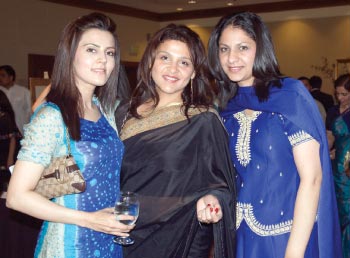 Guests at the DIL fundraiser in San Jose, Calif. Guests at the DIL fundraiser in San Jose, Calif.Dr. Sheikh, who also happens to be a professor of psychiatry and behavioral sciences at the Stanford University School of Medicine, certainly knows a great deal about anxiety and he did not take too long in putting the 400 or so in attendance at ease. He explained the housekeeping and the agenda for the evening and said that the target was to raise $75,000 during this fundraiser of which $55,000 had already been raised. A raffle and a silent auction of special gifts were also on the cards and last but not least, the envelopes were there at each table for individual contributions. He also thanked the 40 or so volunteers, Platinum Sponsors Bhoomija and Saeed Malik and Roya and Shahid Sheikh, OPEN president Umair Khan, and all the lovely models who volunteered their time to be involved with Hassan Shehryar Yasin’s fashion show. Dr. Sheikh had a few more comments to add. “There is no better way to start nation building than to take young girls and educate them,” he said. He gave the example of Sir Syed Ahmad Khan and the Aligarh Muslim University model as an effort to emulate and invited DIL San Francisco’s Sara Abbasi to say a few words. Abbasi welcomed and thanked everyone on behalf of the DIL Board. She went into an introduction into the great work that the organization has been doing in various impoverished and educationally underserved areas of Pakistan and wanted everyone to know that the girls there really want to get educated. DIL schools only go up to the 9th Grade. “The fact that these girls want to continue their education past the 9th Grade is heartening,” she said. She also shared a unique experience on a trip to Baluchistan Province. A non governmental organization working there with DIL used jeeps to travel around the area to promote female literacy, and one day found one of its jeeps and the people in it forcibly taken away by armed men. Everyone was concerned about their safety till they showed up later to tell their amazing story. It appeared that these armed men had heard that wherever this jeep visits, a girl’s school is opened, so they decided to take the jeep and the team to their own village in the hope that such a school will open there too.  Models display outfits by Pakistani fashion designer Hasan Shehryar Yasin. Models display outfits by Pakistani fashion designer Hasan Shehryar Yasin. Sara added that DIL was working hard this year in the areas impacted by last October’s earthquake in Pakistan. Temporary schools were being set up in areas like Manshera, and that a really ambitious effort was under way to get children back to their studies. Dr. Sheikh came back on to the podium quoting the poet Allama Iqbal and proceeded with the showing of a moving video/DVD presentation on DIL’s School Activities. Just watching these girls who were determined to get an education was a moving experience. Imagine, if circumstances had been different, these could have been our own children! From the mountains to the plains, DIL schools are certainly making an impact (and God bless them).  Pakistani fashion designer Hasan Shehryar Yasin. Pakistani fashion designer Hasan Shehryar Yasin.Keynote speaker Saeed Malik next addressed the gathering. Chairman and founding member of Silicon Turnkey Solutions, Malik has been described as a serial entrepreneur on occasion and has already had a number of business successes here in Silicon Valley. He is an alumnus of the University of Karachi and San Jose State University. But beyond that (as we discovered on this occasion), he can move people with both his sensitivity and eloquence. This was one of the best speeches heard at our community events for quite some time. “This is the night of DIL,” he said. He was all praise for this organization that strives to bring the written word to children who would otherwise have been deprived from reading. He spoke of love and passion, quoting from the Pakistani poet Faiz Ahmad Faiz and Lebanon’s Kahlil Gibran. But it was the picture of the slum outside of Karachi that Malik painted that was really special. “It is 8:05 a.m. in Orangi Town in Karachi, Pakistan….” He described the battle for survival there and poor children waking up. “Certainly no clothes to change,” he said. “If they live long enough, these children will find the curse of the slum. Life in the slums has very few escape hatches,” he added. But he said that miracles do happen but “you cannot win the lottery without first buying a lottery ticket. Miracles do happen to those that are ready for them.” “Learning is wealth for the poor and an ornament for the rich,” he said. “Miracles tend to happen where there is less rather than more,” he said. Malik spoke of a girl named Gul Bahar (the Flower of the Spring). “Who says that flowers don’t grow in the slums?” He was full of praise for the efforts being made here. “Thanks to people like you and volunteers of DIL, a miracle is happening at this very moment,” he said. “I must congratulate this organization for forging ahead.” He ended with an appeal: “Teach the child the written word. When you sleep tonight the sun will have risen in Orangi Town…” 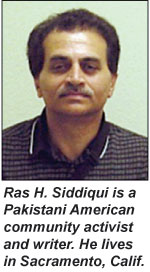 The silent auction, raffle and fundraiser took place during and after a fine dinner catered by Mehran Restaurant (the event raised over the target $75,000) after which came the much awaited fashion show. The silent auction, raffle and fundraiser took place during and after a fine dinner catered by Mehran Restaurant (the event raised over the target $75,000) after which came the much awaited fashion show.Fashion designer Hassan Shehryar Yasin is certainly making his mark abroad now since his impressive beginnings in Pakistan. He had for the audience this evening a wide variety of women’s clothing that the models were able to gracefully display. He said that he wanted the world to know that Pakistan was a moderate and progressive country and not the extremist place that some may think. His clothing lineup during this presentation was progressive, tasteful but not daring. Hassan is certainly media savvy, projects himself well and his HSY collection certainly speaks a great deal of his abilities. So DIL San Francisco now has another big fundraising success to its credit. It certainly was a glamorous evening during which people had a great time and all for a wonderful cause. And for Pakistanis here, it just doesn’t get much better than this, because for the cause of education of girl children, our heart — DIL — beats as one. |TOP| CULTURE: Ode to Tagore, Nazrul: An Evening of Bangla Songs Bangla music lovers, mark your calendars. On 26 August, two top exponents of Rabindra Sangeet and Nazrul Geeti will perform live in Berkeley, Calif. A Siliconeer report. 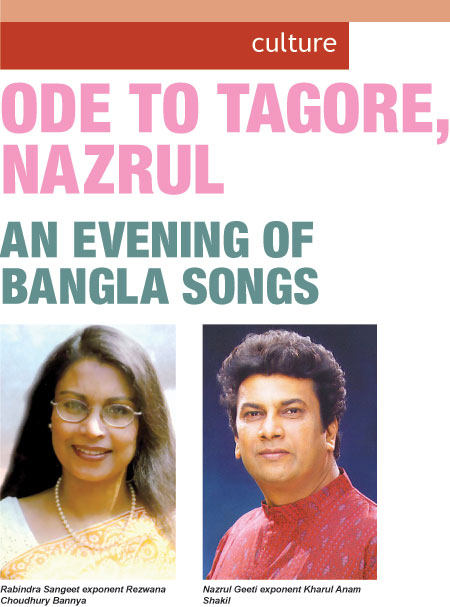 For Bangla-speaking music lovers, Rabindra Sangeet and Nazrul Geeti are two of the most popular genres of light music. And two of its most distinguished exponents, Rabindra Sangeet singer Rezwana Choudhury Bannya and Nazrul Geeti singer Khairul Anam Shakil will be presenting an evening of Bangla songs Aug. 26 at the University of California at Berkeley. For Bangla-speaking music lovers, Rabindra Sangeet and Nazrul Geeti are two of the most popular genres of light music. And two of its most distinguished exponents, Rabindra Sangeet singer Rezwana Choudhury Bannya and Nazrul Geeti singer Khairul Anam Shakil will be presenting an evening of Bangla songs Aug. 26 at the University of California at Berkeley. The concert is being presented by the International Institute of Bengal Basin, a Berkeley, Calif., based nonprofit which is focused on exploring ways of handling environmental challenges in the Bengal Basin, a geographic area that includes Bangladesh and the Indian state of West Bengal. To the rest of India, Rabindranath Tagore is a sage and author of the Indian national anthem. To Bangla-speakers, he is the affectionate paterfamilias of modern Bengali literature and culture. The appeal of Tagore, Asia’s first Nobel laureate, transcends political boundaries as Bangladeshis also sing his ode to Bengal, “Amar Sonar Bangla,” as their national anthem. Tagore’s surpassing talent continues to enthrall Bengalis. There is virtually no area of Bangla literature and culture that did not benefit from his talent; he was a sage, essayist, novelist, an exquisite short story writer, a deeply perceptive poet, a painter, and an educator with farsighted ideas who tried to bring them to fruition at Santiniketan, his unique institution in West Bengal’s Bolpur. Kazi Nazrul Islam was a wild tornado of talent who swept pre-partition Bengal with his youthful energy and vigor. He wrote revolutionary poetry that could get the blood of a freedom fighter boiling, and his songs inspired Netaji Subhas Chandra Bose so much that the Bengali leader loved to take him along in his rallies. All his life Nazrul fought against fundamentalism, superstition and obscurant behavior, especially among Muslims. The October revolution in Russia in 1917 inspired Nazrul deeply, who cared passionately for the underdog. He was also outspoken against British rule, who jailed him. What was remarkable about him was that though the son of an imam, he was equally comfortable writing Islamic songs as he was writing Hindu devotional songs. His songs are a delightful cornucopia of rich and diverse influences: Hindustani classical influences, even the ghazal, was as welcome as traditional folk music influences. For details of the concert, send an email to the following address: Ashfaque.swapan@gmail.com. |TOP| HEALTH: Taking on Insomnia: A Few Simple Steps A few simple steps could help relieve insomnia, advises Dr. Deborah Gould, MD.  Most people have trouble sleeping from time to time. Stress from work, loss of a loved one, relationship and money problems and other worries can interfere with normal sleep. However, if you have difficulty sleeping for more than three weeks, you may have insomnia. Insomnia is the most prevalent sleep disorder, affecting over 37 million people in the United States and over 100 million people worldwide. Symptoms of insomnia include:
Contributing factors to insomnia include consuming caffeine, alcohol, tobacco, and medicines that keep you awake as well as stress and over stimulation prior to going to bed such as watching TV or exercising.
COMMENTARY: Canards and Attacks: The Hindutva Onslaught Activist Sandeep Pandey writes that committed volunteer groups like Asha and AID and people like himself are the target of nervous rightwing groups because the Sangh Parivar cannot answer a simple question that even committed RSS supporters are asking: Where has the money collected to build a Ram temple in Ayodhya gone?  During my last visit in October 2005 to the U.S. and Canada there was renewed propaganda against me by the rightwing Hindutva groups which have branded me as a terrorist or a Naxalite. They even tried to unsuccessfully prevent my entry into the U.S. by reporting to the airport authorities at San Francisco that I was arriving on a particular day. On my second day at two meetings at Stanford and in the Bay Area one or two people came to protest. They were shouting and distributing false information outside these events. They have even circulated an anonymous questionnaire for me over the Internet asking me to clarify my stand on certain issues. In this article I would like to examine the question as to what interest of the Hindutva groups am I hurting because of which they have to go after me in the U.S. with a blatantly malicious campaign? Who are these people who refuse to identify themselves? The person who was distributing fliers outside the Westin Hotel event would not reveal his name or that of his organization. He kept telling me that I should dissociate myself completely from CPI(ML) because it was a group that supported armed revolution. After having told him that I did not support violence and only supported the pro-poor stands of this party, when I asked this person to come and have a dialogue with me inside the hotel he just kept repeating the accusations. I invite my rightwing friends to prove if I have ever been involved in any violent action or have ever instigated a violent action. Just because I attend some meetings of CPI(ML) doesn’t mean that I support violence. Guilt by association is not acceptable. The reason I like to work with communist parties, even though I’m not a member of any party, is that they are among the very few parties in India which raise the issues of poor and marginalized communities, a constituency that I share with them because of my Gandhian orientation. I find that communist parties are the only ones among the mainstream parties who are not just in the game for acquiring political power by any means. They are less likely to compromise on their ideological positions. They are the ones raising issues of land reforms and fighting to get land rights to landless dalits. Sometimes these struggles get violent. I have once seen activists of CPI(ML) at the receiving end of violence in Ballia District of UP when they were taking out a procession of dalit labourers against powerful landlord castes. Communist parties are probably also the most honest ones when it comes to keeping accounts of their funds. And most importantly they are brave. In Siwan, Bihar, they are the only ones who can take on the powerful mafia don MP Shahabuddin in spite of getting into quite violent situations at times. The activists of CPI(ML) are not cowards who prefer to remain anonymous, running slander campaigns from the safe confines of the U.S. If our rightwing friends think that they can scare people away in the name of communists they are mistaken. In India communist parties are playing a very important role and ruling two very important states. CPM is in power in West Bengal for the longest time any single party has held power anywhere in the country and the left parties clearly have an important role in the running of present UPA Government at the centre. CPM-CPI-RSP-Forward Bloc are exerting important influence on the Congress-led Government to ensure that it doesn’t compromise on the interest of common people of the country. One allegation I face is that I support only Muslim organizations and don’t work for Hindus. In Ayodhya I have been working mainly with Hindus, some of them like Acharya Satyendra Das, the chief priest of the Ram Lalla temple (the makeshift temple at the disputed site), important sadhus and saints, to form a forum called the Ayodhya ki Awaz. This forum has played an important role in providing a platform to the common people of Ayodhya who had gotten fed up of the politics of temple construction. This forum wants all parties using the Ayodhya issue for their political gains to keep out of Ayodhya. They feel that the Hindus and Muslims of Ayodhya are capable enough of solving the Babri Masjid-Ram Janam Bhumi dispute and outsiders must respect their sentiments. The politics of using religion got exposed around 2003 when people of Ayodhya started asking the question that why do Ram Sevaks/Ram Bhakts/Kar Sevaks from all over India come to Ayodhya not with construction material or equipment but with trishul in their hands? What has the instrument of Lord Shiva got to do with Ram temple construction? The politics of trishul meant to spread hatred was exposed and since then people of Ayodhya, UP and India have rejected this communal politics. I should also mention that when Ashok Singhal was distributing trishul in Sultanpur, I, along with other friends, was distributing Gita from the platform of Loktantrik Samajwadi Party and eight times more people came to our program, clearly indicating their preference for what they thought was a better symbol of Hindu religion! 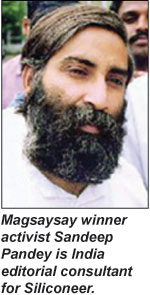 This propaganda against me is there only in the U.S. and over the Internet. Along with me groups like Asha and AID are also targeted. If we carefully look at the reason it is quite clear that RSS is perturbed by the fact that it now has competitors. Since the rightwing Hindutva groups have started losing credibility, because they have not been able to account for the money and bricks collected for constructing the Ram temple in Ayodhya, their donor base is shifting to more genuine organizations involved in community development work in India. The funds raised from all over the world for temple construction in Ayodhya were never deposited in the VHP account. The temple never got built and nobody knows where all that money went. This question is being asked by committed RSS supporters. The rightwing Hindutva groups have cheated the unsuspecting middle-class Hindus who were innocent supporters of their temple movement. These middle-class Hindu families now find secular alternatives like Asha and AID more reliable. Both Asha and AID have a policy of transparency with the funds that they collect and anybody can visit their Web sites to find how much they collect and where exactly it goes. All funds and projects are up for all to see and if volunteers make a mistake, they are willing to take criticism, and make changes. These are also groups that are based on values of equality, rights, and empowerment of all. Asha, a group which I help found, has a policy of zero overheads, functions in a decentralized fashion and is completely accountable to its donors. My last trip to the U.S. and Canada was funded not from donations to Asha but by individual contributions from volunteers. Similarly my present trip is not paid for with Asha’s money. People find the spirit of volunteerism in Asha and AID quite refreshing and hence choose them over Hindutva groups which are closed groups that have traditionally been hierarchical, and non-transparent. This propaganda against me is there only in the U.S. and over the Internet. Along with me groups like Asha and AID are also targeted. If we carefully look at the reason it is quite clear that RSS is perturbed by the fact that it now has competitors. Since the rightwing Hindutva groups have started losing credibility, because they have not been able to account for the money and bricks collected for constructing the Ram temple in Ayodhya, their donor base is shifting to more genuine organizations involved in community development work in India. The funds raised from all over the world for temple construction in Ayodhya were never deposited in the VHP account. The temple never got built and nobody knows where all that money went. This question is being asked by committed RSS supporters. The rightwing Hindutva groups have cheated the unsuspecting middle-class Hindus who were innocent supporters of their temple movement. These middle-class Hindu families now find secular alternatives like Asha and AID more reliable. Both Asha and AID have a policy of transparency with the funds that they collect and anybody can visit their Web sites to find how much they collect and where exactly it goes. All funds and projects are up for all to see and if volunteers make a mistake, they are willing to take criticism, and make changes. These are also groups that are based on values of equality, rights, and empowerment of all. Asha, a group which I help found, has a policy of zero overheads, functions in a decentralized fashion and is completely accountable to its donors. My last trip to the U.S. and Canada was funded not from donations to Asha but by individual contributions from volunteers. Similarly my present trip is not paid for with Asha’s money. People find the spirit of volunteerism in Asha and AID quite refreshing and hence choose them over Hindutva groups which are closed groups that have traditionally been hierarchical, and non-transparent.There was a time when in a disaster like the one at Bhuj, RSS was the first one to enter to carry out relief operations, but now AID was able to mobilize $3 million and played a more active role in tsunami relief. This is something very difficult for RSS to digest. Hence their supporters are indulging in unreasonable mud slinging. It is a well-known fact that the Hindutva movement in India was funded in a major fashion by NRI money. With the Hindutva politics in disarray at home in the aftermath of L.K. Advani’s deviation from the communal ideology, Uma Bharati’s exit from the party and unfortunate happenings in the Pramod Mahajan family, the shifting donor base of these organizations in the U.S. has become a major source for concern for them. That explains the reason why these Hindutva groups are active against somebody like me only in the U.S. |TOP| THEATRE: Kala Pul: Karachi, Through a Dark Lens Karachi-born playwright Saqib Mausoof brings weapons, drugs, extremists of all hues and the partying rich together into a combustible mix in his dark, brooding rumination of a city out of control, writes Ras H. Siddiqui.  (Left, top): The promotional poster of “Kala Pul.” (Left, top): The promotional poster of “Kala Pul.”(Bottom): The cast of “Kala Pul” takes a bow in front of the audience after a performance. Every once in a while, creative writing juices flow in the English language through the Pakistani-American community here in the San Francisco Bay area producing something noteworthy. In the past couple of years, local playwright Wajahat Ali has tackled the post 9/11 impact on a Pakistani American family with his Domestic Crusaders and rattled quite a few critics and observers with that effort. Now Karachi-born actor and writer Saqib Mausoof has taken a different route with Kala Pul (Black Bridge) producing results not unlike Satyajit Ray’s Asani Sanket (Distant Thunder) to expose the impact of 9/11 in Pakistan. In this play, in a unique way the World Trade Center attacks lead to the death of one member of a family in Karachi. But that is not all or the only focus of the play presented at the Cellspace on Bryant Street in San Francisco. 9/11 plays a minor role in Kala Pul , but its impact on an already divided ethnic, religious and economic city is certainly felt distantly. The narrator (Ali Mumtaz) introduces us to Karachi by quoting Sir Charles Napier; “One day she will be the Queen of the East,” he had said a century ago. The main character Arsalan Mirza (Brian Dean) is introduced as a hero/antihero who has not outgrown his violent past. He lives in hiding in Dubai and comes back to Karachi after consulting with the wise Parvati (Ashok Malani took over that role in the absence of Ijaz Syed). Arsalan wants to find out the truth about the killing of his brother Hamza and to avenge it. He returns to his home after 12 years and finds his grieving father Abu (Rak Pakala) who is delighted to see his son. Abu curses a political party and its leader for the mess that has been created, and calls him a traitor. “Mir Jaafar kahin ka,” says Abu. Arsalan also finds out that his sister Alia (Maheen Adamson) has become quite independent and has taken over the responsibility of running the household. His youngest brother Osman (Atif Naqvi) is exhibiting extremist religious tendencies, but what is noteworthy is that their father figure Abu, the immigrant Mohajir from India, shows little support for any extremist views. Between Abu, Alia and Osman, Arsalan gets quite a homecoming, but it is when he meets his old friend Nizam Elahi (Khurram Anees) and his wife Mona (played by Tania Ahmad) and her sister, the vivacious Zoya Kamal (superb acting job by Aaliya Dadabhoy), that things get really interesting. There is plenty of beverage consumption during this play, but the local stuff is missing. “No desi in this house,” says Nizam, after Arsalan asks for a Murree beer. There is also a great deal of profanity in this script, along with adult innuendos, so this play can be deemed for mature audiences only. Divorced Zoya takes an interest in Arsalan and volunteers to show him around. Next, we are introduced to the liberal and intoxicated Karachi at a French beach party through Zoya’s ex-husband Naufil Kamal (Muder Kothari), who hits her after an argument. Zoya’s interest in Arsalan matures after he is perceived to be protecting her. 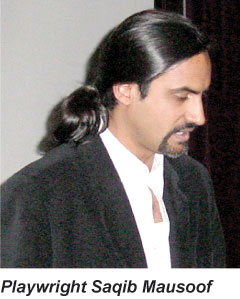 A high-energy Bollywood-style dance performance by four dancers from Dhol Rhythm pleasantly distracts the viewer next, as we get ready for the next part of the play. A high-energy Bollywood-style dance performance by four dancers from Dhol Rhythm pleasantly distracts the viewer next, as we get ready for the next part of the play. We are introduced to ICEY (Sonny Harris) who runs his own “security company.” He recalls Arsalan’s past and offers to forward his request for information. We next see Arsalan sharing a beach view with Michael Lopez (Ali Mumtaz), a gay, Christian DJ who is also in the business of selling the light weaponry which Arsalan requires. They talk turtles, drugs and guns; “Some kind of revenge killing?” inquires Michael, as he completes a transaction to be delivered later with the help of Linda Perez (Rabia Razak), also known as Madame X. Arsalan is arrested and beaten up in a lockup by a police inspector (Muder Kothari), and is saved by Suleiman Brohi (Ashok Malani) in the nick of time. Suleiman is a multi-talented individual, calls himself a trader, a Sufi mystic and self-proclaimed Karachi historian. In the mean time Arsalan’s young brother Osman is showing increased extremist tendencies (TV reports are helping him there). Arsalan and Alia (reluctantly) visit their murdered brother Hamza’s grave. There is some inference of or discussion on the significance of Kala Pul throughout the play as the bridge that divides the lifestyle of Karachi’s rich and those less fortunate. But in this two hour play, little time is devoted to the poor side as we are to visit the Nando’s chicken fast food outlet. Alia is full of information here on how you can find anything in the world that you want in Karachi, Pakistan now. “The only thing that you cannot find here are parking and Osama (Bin Laden),” she says. We are also introduced to journalist Rab Nawaz (Muder Kothari) who is full of information, too. He informs Arsalan that his brother was probably not murdered by the fundamentalist Lashkar. He brings up the volatile situation in Karachi, Daniel Pearl’s murder and of course America’s CIA, India’s RAW and Pakistan’s ISI. Here we also learn about Maulana Zahoor (Saqib Mausoof) who heads the Lashkar fundamentalists. Saqib Mausoof does not make just a cameo appearance playing the role of the Maulana Zahoor character here. “We don’t do drive by shootings,” he says to Arsalan absolving his organization in his brother’s murder. He also tries to recruit him for the cause. “Choose your side now,” Arsalan is told.  All the main characters have been introduced in this writing and the khichri ingredients have been identified in this play. From here on, the scenario of weapons, drugs, extremists of all hues and the partying rich come together in a volatile ending. Saqib Mausoof is not one to hold back, either in language use or content. Kala Pul comes to a wild climax where the innocence of the sea turtle’s return to the Karachi beaches is the only significant presence remaining. All the main characters have been introduced in this writing and the khichri ingredients have been identified in this play. From here on, the scenario of weapons, drugs, extremists of all hues and the partying rich come together in a volatile ending. Saqib Mausoof is not one to hold back, either in language use or content. Kala Pul comes to a wild climax where the innocence of the sea turtle’s return to the Karachi beaches is the only significant presence remaining. It is not the purpose of a review to give away the storyline. The acting in this play was not by seasoned professionals but it was still collectively impressive. Saqib has penned a powerful mix here in Kala Pul. Those of us older viewers (who refuse to give up on the Karachi of our youth) will be disturbed by this play. But then again maybe that is the intent of the author. Kala Pul is a symbol of separation here, but it could also become a bridge of hope and understanding as well, if the people in Karachi want to resurrect “the Queen of the East” and bring the city back from the brink. (This performance of Kala Pul was dedicated to the stateless Bihari Refugees stranded in Bangladesh for over three decades. It was sponsored by Friends of South Asia.) |TOP| POLITICS: The Odd Couple: Sonia Gandhi and Manmohan Singh A recent countrywide survey may have placed Prime Minister Manmohan Singh notches above Congress party leader Sonia Gandhi as the best suited person to lead the country, but Manmohan knows better who is boss, writes Siddharth Srivastava. 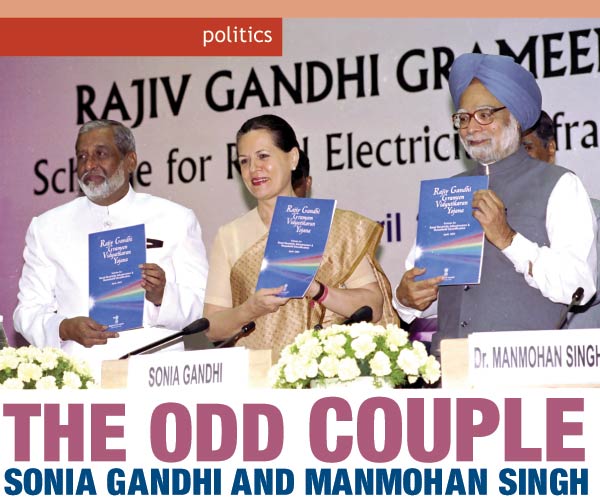 Prime Minister Manmohan Singh (r), National Advisory Council chair Sonia Gandhi and the union Power Minister P.M. Sayeed at the launch of the Rajiv Gandhi Grameen Vidyutikaran Yojana in New Delhi in April 4. (PIB photo) They are referred as the odd couple of Indian politics. Even as the Congress-led United Progressive Alliance completed two years in office this week, the focus has been on the two individuals at the helm: Prime Minister Manmohan Singh and party president Sonia Gandhi. It is a unique instance in Indian political history that a person considered more powerful than the head of government holds the top party post. A recent countrywide survey places Manmohan notches above Sonia as the best suited to lead the country, given his rise from a village to study at Oxford, work at the World Bank, head the federal bank of India, finance minister and now. But Manmohan knows better who is boss. Sonia owes her position to the powerful lineage of the Gandhi family and insights into Indian politics, living in the shadow of her late mother-in-law Indira Gandhi and husband Rajiv Gandhi, both former prime ministers of the country. 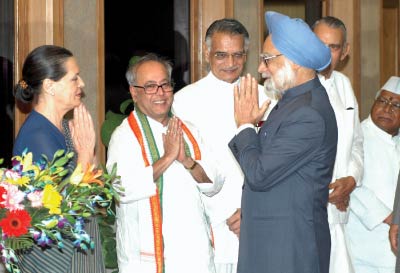 Prime Minister Manmohan Singh being seen off by cabinet colleagues before his departure for a trip to Germany and Uzbekistan in New Delhi. UPA chair Sonia Gandhi is also seen. (PIB photo) Prime Minister Manmohan Singh being seen off by cabinet colleagues before his departure for a trip to Germany and Uzbekistan in New Delhi. UPA chair Sonia Gandhi is also seen. (PIB photo)When Sonia selected Manmohan in May 2004 to lead the country after the unexpected victory of the Congress party over the ruling Bharatiya Janata Party, the Cassandra’s did not give the relationship too much of a chance. Yet it has endured and most say that it is stronger than ever before. It has survived the intrigue and jealousies within the Congress party with stalwarts such as Defense Minister Pranab Mukherjee and Human Resources Minister Arjun Singh who fancied being in Manmohan’s position, once it became clear that Sonia was not interested to be in the direct line of fire, given her foreign origins (she is Italian born), which would provide quick fodder for the opposition. Pranab has since aligned himself with Manmohan to emerge as the second most powerful minister while Arjun is said to still harbor misgivings and fancies his chances of becoming the president of the country, an honorary post, but the highest public functionary under the constitution. 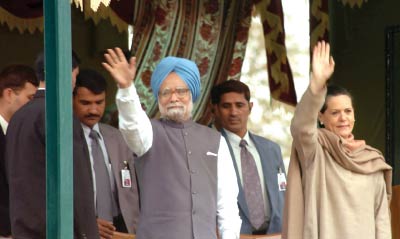 Prime Minister Manmohan Singh and National Advisory Council chair Sonia Gandhi waving at a crowd before flagging off the Srinagar-Muzaffarabad bus in Srinagar. (PIB photo) Prime Minister Manmohan Singh and National Advisory Council chair Sonia Gandhi waving at a crowd before flagging off the Srinagar-Muzaffarabad bus in Srinagar. (PIB photo)Indeed, the key difference lies in the personalities of Manmohan and Sonia. Sonia is conscious of her aggressive role as a mass leader rooted in the political realities of the country, where the majority is still poor and people can be influenced by caste and religious affiliations. She knows as much as the late Indira did that image counts for a lot in the country. Rural India had an unbreakable emotional bond with Indira, despite her failure to actually deliver succor to the poor from their material miseries. On the other hand, Manmohan, a trained economist, has never won a direct election (and has no aspiration to do so after losing his only attempt) and is a gentle, diplomatic visionary who looks at India through the definitions of growth, market forces, competition, foreign investment, exchange reserves and economic prosperity. It is a process the benefits of which take time to percolate to the individual voter. The BJP was rudely jolted in 2004 when it lost the elections on the head of an “India Shining” campaign, thought out by stalwarts such as L K Advani and the late Pramod Mahajan. Such an India exists for many, but the key point it that it does not for many more, and it is that majority that gets to decide who will be the political party in power. Indeed, observers point that Sonia has allowed Manmohan complete freedom and trusts his judgment more than anybody else to pursue his dreams on subjects that may not impact the immediate political future of the Congress party, but will be good for the nation in the longer run. Thus Manmohan more or less has a free hand and her backing in economic reforms (though he has to constantly grapple with the Left), Indo-U.S. relations and the nuclear energy pact and Indo-Pak relations, aspects that the BJP under Atal Behari Vajpayee was also good at. These issues go down well with the 300 million affluent and middle classes who do not want the government to become an impediment as they go about their business of making more money in a globalized environment, outsourcing opportunities and a surfeit of multinational and service sector jobs. Sonia knows that it is the rest of the 700 million who are not yet part of this growth scenario whose aspirations have to be addressed as well, or her party faces the fate of the BJP. Sonia’s efforts have been in trying to ensure that her party’s efforts/image does not become too distant from this bigger picture. The one ramification has been the massive rural employment program that she has explained is an effort by the government to transfer resources from the rich to the needy. To meet the expenditures, the government has been looking to increase the tax base and bring under the tax net more segments within the fast growing service sector. This is seen as necessary concomitant to growth with social justice in a democracy. The government has also mooted a huge social security plan for the unemployed, farmers and peasants that will entitle them to pension, health benefits and other doles. 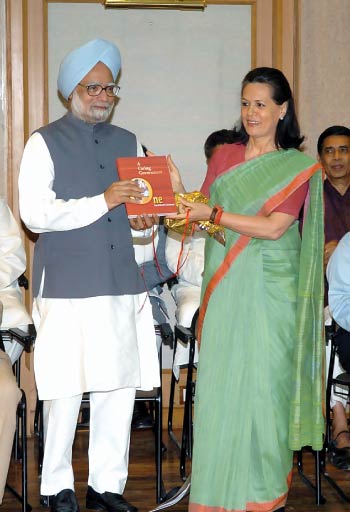 Prime Minister Manmohan Singh handing over a copy of a report of the first year in office of the UPA government entitled “A Caring Government — One Year of the UPA Government” to National Advisory Council chairperson Sonia Gandhi in New Delhi. (PIB ohoto) Prime Minister Manmohan Singh handing over a copy of a report of the first year in office of the UPA government entitled “A Caring Government — One Year of the UPA Government” to National Advisory Council chairperson Sonia Gandhi in New Delhi. (PIB ohoto)Also noteworthy, Sonia has also been very careful to cultivate and buttress her image of standing for high morals in public life, as demonstrated by her resignation and reelection to Parliament following the office-of-profit controversy recently. The trickier aspect of this socio-economic re-engineering has been reservations for backward castes who form 50 percent of the country’s population and are key to government formation in the north Indian states generally referred to as the cow belt. The Congress has been eyeing the big state of Uttar Pradesh for a while now, as its political fortunes and seats in Parliament are linked to its performance here. Sonia’s son Rahul has made it a test case for his political initiation. The government has, for the time being, put the issue of quotas in private sector firms in the backburner due to fierce resistance by industry, but decided to move ahead with reservations in centrally funded higher educational institutions, including prestigious medical, engineering and management colleges. Due to massive nationwide protests by higher caste students (mostly from the middle class) who see merit/their chances being sacrificed for narrow political gains, the government has decided to sugarcoat the quota pill by a commitment to proportionately increase the number of general category seats. Political observers believed that the quota gamble was a turf war between Manmohan and Arjun, who spoke about the proposals out-of-turn. But, it has emerged that Arjun always had the blessings of Sonia. Some observers see a silver lining as quotas should result in the revamping of the education infrastructure, but many are unhappy, as they want government affirmative action on ramping up primary education, the basis of competition at an equal footing. Using reservation as a political instrument (with an added balm of the upper caste students) could go either way for the Congress. The party could end up losing the middle votes and not win the backward castes who have strong affiliations with regional and caste-based parties. The strong constituency of middle class voters who have always backed Manmohan’s sagacity could be eroded. It could allow the BJP to spring back. Aggressive Hindutva is a ploy often used by the BJP. It worked in the 90s and boomeranged in 2004, so the party is in the throes of a dilemma. However, the BJP has its plate full with a slew of scandals and deaths, and is in no position to take on the Congress. Sonia’s political compulsions and instinct tell her quotas are necessary to keep the majority with her (OBCs, after all, are a numerical majority). Manmohan (who was reportedly not happy with quotas initially) has quietly fallen in line, keeping their relationship on an even keel. The big question is will Sonia’s gambit pay off politically, socially, economically? Only time will tell. Siddharth Srivastava is India correspondent for Siliconeer. He lives in New Delhi. |TOP|
TRAVEL:
Ghosts of Groveland: Gold Rush Country There is much to keep you in Groveland, California, writes Al Auger. The simple atmosphere of a true Gold Country town is strong down Main Street. Anchored by the Iron Door Saloon and the Hotel Charlotte, there is a pervading sense of having gone back in time.  Built in 1852, the Iron Door is the longest operating saloon in California and is redolent of the Gold Rush era. Little has been changed, the windows and door are still the original massive iron slabs. Built in 1852, the Iron Door is the longest operating saloon in California and is redolent of the Gold Rush era. Little has been changed, the windows and door are still the original massive iron slabs.It was one of those truly extraordinary fall days in the foothills of Highway 120, the “Gold Rush Gateway.” On our way to Yosemite National Park, we stopped off in the rustic burg of Groveland, located on Highway 120 just 24-miles from the entrance to Yosemite, to see old friend Peter Barsotti, from our rock ’n’ roll days with Bill Graham Presents. Peter and his late wife, Bettika, left behind them the frenetic life of rock ‘n roll producers for the Bill Graham Presents juggernaut. They settled in restoring the Iron Door Saloon, a Groveland and Gold Rush icon, to its magnificent past. Built in 1852, the Iron Door is the longest operating saloon in California and is redolent of the Gold Rush era. Little has been changed, the windows and door are still the original massive iron slabs. Inside, the atmosphere is dark and musty. The history-laden edifice has been refurbished inside and offers full dining as well as lodgings. The weekends have been enlivened with musical entertainment from blues to rock ‘n roll and opera.  Deciding to stay the night in Groveland, we picked out the charming Hotel Charlotte across from the Iron Door. Built in 1918 by Charlotte DeFerreri, the hotel housed the workers building the Hetch Hetchy Water Project that would supply water to San Francisco. Deciding to stay the night in Groveland, we picked out the charming Hotel Charlotte across from the Iron Door. Built in 1918 by Charlotte DeFerreri, the hotel housed the workers building the Hetch Hetchy Water Project that would supply water to San Francisco.No Mother Lode country hotel worthy of the name is complete without a resident ghost with his or her own love story. Serendipity was riding with us, being just a few days before Halloween. Our specter was a cipher, according to the manager of the delightful bed and breakfast hotel. “Well,” she advised with a suspicious twinkle in her eye, “no self-respecting old hotel could exist without its’ ghost stories. The hotel has been named for ours.” The story of the ghostly Charlotte, she told us, “has been lost with time, but many locals have told me a number of versions they say their family has passed down from generation to generation.” Whether or not Charlotte still haunted her hotel, she dominated our conversation long into the night. My getaway companion decided — if there really was a ghost here — it was the broken-hearted Charlotte constantly searching for her lover who disappeared one night during a liaison at the hotel. “Charlotte and her lover has spent a night of splendiferous dining and lovemaking that tragic night,” my friend began. “Some time in the wee hours of the night, Charlotte was awakened by a terrible pressure on her heart. Sitting up, her fear-laden heart was beating a tattoo in her chest. “The pillow beside her was empty, her lover was gone leaving only an indent and warmth of his body on the covers. His clothes and all his valuables were still there, but he was nowhere to be found. Charlotte’s pain and confusion so took hold of her, in a feverish moment of melancholy she slashed her wrists with the straight razor he left behind.”  Beautiful Yosemite Park is only 24 miles away from Groveland. Beautiful Yosemite Park is only 24 miles away from Groveland.My companion looked at me with moist blue eyes and said, “She died alone, still longing for her lover. And now Charlotte walks the lonely hallways at night sighing his name.” At the moment, I couldn’t top that one. Sometime around midnight I was awakened (truly) by small, “clicky” footsteps on the ceiling. “Someone could walk a bit softer at this hour,” I thought. Then it dawned on me, there was no third floor in the hotel, only the attic. And the truth — as I created it — made itself known: it was actually Charlotte’s little 4-year-old namesake daughter, who died of pneumonia in her mother’s arms. And ever since, the little girl has been haunting the attic playing with her dolls and toys that were moldering away in the dust and darkness, waiting for her mother to wrap her strong arms around her in a big hug and feel the comforting warmth of her soft bosom. “Not bad,” my friend agreed the next morning. In the morning, we enjoyed the complimentary full buffet breakfast that offers lodgers a choice of hotcakes or waffles, choice of cold cereal or oatmeal, fresh fruit, yogurt and toast, English muffins, rolls, bagels or pastries. The dining room is open for lunch and dinner, as well. Since 2003, new owners Lynn and Victor, have restored the ten rooms with fresh paint and wallpaper while some have had new carpets, bathroom tile and wainscoting installed. Others have new furniture including beds and dressers and all are equipped with air conditioning. The dramatic false front, shaded porch and signage has been restored to its original grandeur. Yet, points out Victor, the historical and romantic past of the hotel has been maintained throughout. It’s obvious they have treated the hotel with love and respect.  The Hetch Hetchy reservoir supplies water to San Francisco. Workers building the project were housed in Groveland’s Charlotte Hotel. Other amenities and modernization include computer and high speed Internet access and wi-fi for those with laptops and compatible wireless modems. A well-stocked game room entertain both kids and adults. Even though the seduction of Yosemite Valley is but 24 miles further up Highway 120, there is much to keep you in Groveland. The simple atmosphere of a true Gold Country town is strong down Main Street. Anchored by the Iron Door Saloon and the Hotel Charlotte, there is a pervading sense of having gone back in time. There is much to be found if you’re looking for more than atmosphere. Close by is the bucolic Pine Mountain Lake Marina with a golf course, stable and airport. A little further away is Lake Don Pedro, one of California’s largest lakes. Here is the perfect stop for fishing, waterskiing, houseboating or just lazing in the sun. Up the street from the Hotel Charlotte is a wonderful museum that illustrates the colorful past of Groveland. And for a touch of that color is the old jailhouse. There’s a ghost everywhere to be found in Groveland. 
- Al Auger is a freelance writer. He lives in Redding, Calif. |TOP|
SPORTS: Cricketmania!: World Cup Live El Segundo, Calif.-based DIRECTV will broadcast two International Cricket Council events — the ICC Champions Trophy in October and the ICC Cricket World Cup in March 2007. A Siliconeer report. 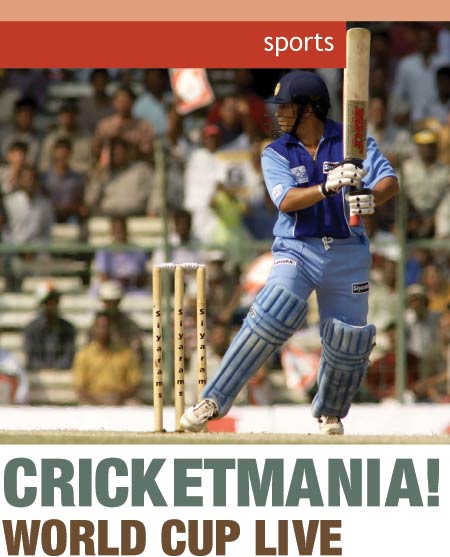 India’s celebrated batsman Sachin Tendulkar has been through a bad patch recently. India fans fervently hope he recovers in time for the World Cup in the West Indies. India’s celebrated batsman Sachin Tendulkar has been through a bad patch recently. India fans fervently hope he recovers in time for the World Cup in the West Indies.El Segundo, Calif.-based DIRECTV has reached an agreement with Global Cricket Corporation to broadcast two International Cricket Council events — the ICC Champions Trophy, to be held in India in October 2006, and the ICC Cricket World Cup, to be played in the West Indies in March 2007. “These are the most prestigious cricket events in the world, and we are proud to offer them to DIRECTV customers for the first time ever,” said DIRECTV vice president Aaron McNally. “With these ICC events, and with exclusive rights to six of the ten test-playing ICC members as part of our CricketTicket package, we are cementing our position as the leading distributor of televised cricket content in the United States.” “Our agreement with DIRECTV is great news for cricket in the United States of America and for the ICC,” said ICC president Ehsan Mani. “DIRECTV’s coverage means people who might not ordinarily be exposed to cricket will get the chance to watch it. And we hope the opportunity to see the world’s best players in the world’s best tournament, the ICC Cricket World Cup, will lead to a significant increase in the number of people interested in the game in the United States, a country which has tremendous potential for growth in cricketing terms.” Ian Frykberg, managing director of GCC, said, “Global Cricket Corporation looks forward to working with DIRECTV at the ICC Champions Trophy 2006 later this year and at the ICC Cricket World Cup 2007 next year.” Television rights to the two ICC events have been acquired by DIRECTV on a non-exclusive basis. DIRECTV’s acquisition of international cricket rights has been part of an effort to expand its programming services for the diverse ethnic population within the United States. DIRECTV customers will need to use a WorldDirect services satellite dish that is capable of receiving both international and English-language programming. In some markets, customers who subscribe to a local channels package will require a second smaller dish. DIRECTV, Inc. is the nation’s leading digital television service provider with 15.4 million customers. |TOP| |